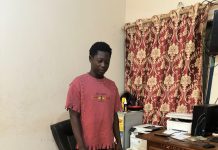The Land Division of the Accra High Court, presided over by Justice Aboagye Tandoh, has been told that the first test report on lithovit fertiliser by the Ghana Standard Authority (GSA) was conducted using standards for water.
According to Fiona Gyamfi, Chief Scientific Officer at the Ghana Standard Authority (GSA) and 6th defence witness (DW6) for Seidu Agongo and Agricult Ghana Limited, the analyst, Peter Quartey-Papafio, tested the lithovit by using the standards for water.
She told the court, under cross examination by Samuel Codjoe, counsel for Dr Stephen Kwabena Opuni, first accused (A1) in the criminal case, that the Forensic laboratory, where Peter Papafio works, lacks capacity to conduct tests on fertilisers.
DW6 said the GSA has six laboratories under the Material Science Department and each is clothed with capacity and areas where a laboratory lacks capacity to conduct a test, it is sub-contracted to a sister laboratory with that mandate.
“Because of the nature of our work, every laboratory has its scope of work, so if you receive a sample and you cannot analyse or the lab does not have the capacity to do a particular parameter or test, the authority allows us to give it to any of our sister labs,” she said.
DW6 said the General Chemistry Laboratory is mandated to test products including agricultural products, household products, building and construction materials as well as water. The forensic lab on other hand undertakes analysis on forensic samples including tissues and narcotics.
Thus, the forensic lab test blood fluids like blood and urine, common poison in food and drinks, poison in human tissues and fluids – liver, kidney, stomach content, blood and urine, as well as heavy metals in biological tissues, food, drinks and other substances.
It tests narcotics and psychotropic drugs in urine, blood, other body fluids, food, drinks and other suspected dozed substances, but not fertiliser.
Discussing Mr. Quartey-Papafio’s report, which suggests that lithovit is harmful to humans and animals, as well as hazardous to water, DW6 said: “looking at the test method here, that is the GS175 part 1, I believe he (Quartey-Papafio) was using the water standard to do the test.”
The witness also informed the court that it never came to her attention that Mr. Quartey-Papafio sub-contracted the sample to her department to conduct the test.
Furthermore, the test conducted by Mr. Quartey-Papafio was done in a matter of a day, May 5, 2017 which is the fastest scientific analysis ever existed in GSA.
Hitherto, the witness said it took the Chemistry Department 21 days to analyse the lithovit sample that was submitted to GSA by Economic and Organised Crime Office (EOCO).
DW6 also stated that at GSA, the fastest scientific analysis ever recorded was five working days, therefore, “it is not possible to analyse in a day.”
Since the two reports from the same organization conflicts, per the norm, the latest takes precedence over the former, particularly when Mr. Quartey-Papafio didn’t challenge the analysis made by the Chemistry Department.
The witness also felt awkward that the General Chemistry lab, which is mandated to test agricultural products like fertilizer, report was not featured in the Dr. Yaw Adu-Ampomah committee report.
In reference to paragraph K of Dr. Yaw Adu-Ampomah committee’s report, which cited Quartey-Papafio’s work that lithovit could not be classified as a fertilizer, DW6 said “it is wrong because even in his report, he is reporting a percentage of urea there and the urea in itself is a kind of a fertilizer.”
She explained that urea is a type of fertilizer, which is nitrogenous in nature. Fertilizer should contain primarily nitrogen, phosphorus, potassium (NPK), but in the case of urea, there is no phosphorus or potassium, it is just nitrogen.
The witness also challenged the statement by the Adu-Ampomah’s committee that Quartey-Papafio’s report was the final report submitted by GSA when the General Chemistry Department analytical results were the latest.
Peter Quartey-Papafio’s report was on May 5 while the General Chemistry Department’s own was conducted from July 26, 2017.
She testified that the assertion by Peter Quartey-Papafio that lithovit is not recommended for its intended purpose cannot be conclusive and to determine that, usually a performance test must be done on the sample to establish its intended purpose.
Counsel Cudjoe then asked the witness, “When you met K. K. Amoah together with his EOCO team, they did not doubt the efficacy of your report Exhibit 133 especially after they had met the GSA officials. That is the position. Is that not it?”
Witness: “I don’t think they doubted it, but they were not convinced that the same institution is producing two conflicting reports.”
Counsel Cudjoe said it was not normal for the team from the Chemistry Department to meet the very head of EOCO to discuss their report, when the sample itself was submitted by the investigation officers of the Office and the witness agreed.
She indicated to the court, during her evidence-in-chief, that at the time the Chemistry Department was contracted to conduct the test, GSA did not have a standard for cocoa fertilizer.
Currently, it is not possible to use the standards at Ghana Standard Authority to establish whether a product can be used as foliar nutrient from nursery, growth and yield stage.
When questioned by Benson Nutsukpui, counsel for Seidu Agongo and Agricult Ghana Limited, about the importance of testing pH value in a fertilizer, she answered that “At the time of the work, there was no Ghana standard for fertilizer. So I don’t know why Mr. Quartey-Papafio tested for it.”
The pH is the acid based nature of the sample and the Density is its weight in relation to volume.
Background
Lithovit Foliar Fertiliser was supplied by Seidu Agongo and his company, Agricult Ghana Limited and purchased by Ghana Cocoa Board with A1 (Dr Opuni) as the Chief Executive.
According to the prosecution, the fertiliser was adulterated and not good for purpose of using it on matured cocoa trees, leading the state to lose over GH¢217 billion.
The three, since 2017, are in court answering 27 counts causing financial loss to the Republic of Ghana
The following is the prosecution’s cross-examination
Q: You did not conduct the test on lithovit, which was brought to your lab.
A: Yes, but it was under my supervision as the head of the lab /Manager.
Q: And you also reported on the test. Is that not so?
A: Yes.
Q: You have never worked in the forensic lab of the GSA?
A: Yes.
Q: You were also not privy to the substance that was tested at the forensic lab?
A: Yes.
Q: You were also not privy to the request for testing that was made to the forensic lab?
A: Yes.
Q: And you have no access to their records books as in the analysts’ books and the sample identification book. Is that not so?
A: At the time of the work, I didn’t have access.









